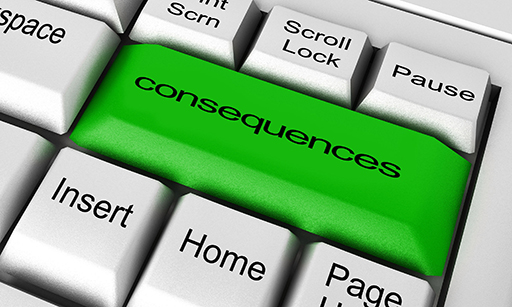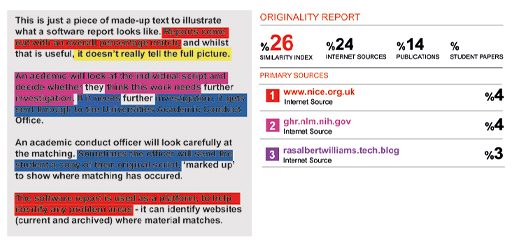3 The consequences of plagiarism: detecting plagiarism
For all the reasons considered so far in this course, educational institutions take plagiarism very seriously, and may use a variety of different mechanisms to identify potential occurrences of plagiarism.

Activity 3
(a) Plagiarism can be detected via automated means. Write down how you think plagiarism can be detected in this manner.
Answer
Automated mechanisms to detect plagiarism include the use of powerful text-matching software tools. There are several different tools available, such as Turnitin. These tools work by comparing the work submitted by students against pre-existing material, such as material in books and journal articles, as well as current and archived content from websites. Such software typically produces an ‘originality’ or ‘matching’ score, often expressed as a percentage.
This matching score is often misunderstood, and there are no clear-cut rules as to what an ‘acceptable’ score is. A high match does not necessarily indicate that the work lacks originality; it may reflect that someone has included quotes and referenced appropriately, or perhaps they repeated the assignment question before they provided their answer. A low match may not mean the material is free from plagiarism.
Figure 2 illustrates how some plagiarism-checking software reports on submitted work. The black text on a grey background represents the students submitted work. The text highlighted in colour represents text that ‘matches’ with other sources. A summary of the locations for those highlighted sections is also provided.
(b) Plagiarism can also be detected via manual means. Write down how you think plagiarism can be detected by manual methods.
Answer
Outputs produced by automated software are usually manually reviewed by subject specialists who apply their academic judgement to interpret the software reports.
In addition, plagiarism may also be identified ‘by eye’.
Those who are teaching modules and marking assignments are familiar with academic and professional literature and often recognise a ‘choice phrase’, or particular argument or writing style.
They are also often familiar with an individual student’s academic ‘voice’ and will notice unusual changes.
Instances of plagiarism are sometimes reported to institutions by other students. For example, where a self-help group has over-stepped boundaries and members of the group feel uncomfortable with sharing of information.

